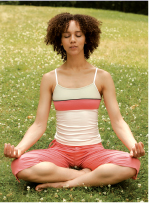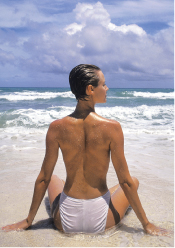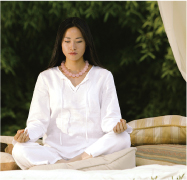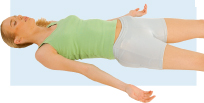Emotional balance
Beyond physical allergen factors that trigger a crisis, it's known that emotional tension can also play a factor in triggering an allergic reaction. Breathing, relaxation, visualization and meditation techniques can be beneficial exercises for preventing and relieving symptoms.

+ Learning how to relax is fundamental to treating allergies. And a key to relaxation is proper breathing techniques. There are three basic types of breathing: abdominal and diaphragmatic breathing; thoracic breathing; and clavicular or collarbone breathing. Complete breathing unites the three techniques and increases lung capacity. This is why these exercises are specifically recommended for allergy sufferers. They also help your overall well-being and increase the strenght of your immune system.
BREATHING
∎ Abdominal or diaphragmatic breathing

Lie down on the floor with your hands on your abdomen. Take a deep breath, inhaling slowly through your nose and send the air to the bottom of your lungs, expanding your abdomen, concentrating your energy in that area. Hold your breath for a few seconds. Then slowly exhale, contracting your abdomen.
∎ Thoracic breathing

In the same position, place your hands over the thorax and concentrate on the energy in this area. Without moving your abdomen, take a deep breath and note how your ribs rise and your chest expands as the air enters.
∎ Clavicular or collarbone breathing

Using the same position, place your hands on your upper chest or on the collarbone. Inhale and exhale through the nose, paying attention to how it feels when the air lifts your ribs, collarbone and shoulders. (The body does not take in sufficient oxygen with this type of breathing, so it's best not to practice this exercise for very long.)
∎ Complete breathing
Complete breathing is a combination of abdominal breathing, thoracic breathing and clavicular breathing.
First, inhale and bring the air to the bottom of your lungs, then to your thorax and finally to your upper chest. Exhale in the same order, letting the air out of the bottom of your lungs, thorax and finally the upper chest.
SITALI BREATHING

This exercise is very beneficial for calming agitated emotional states, in particular anxiety which is so typical of the diagnostic picture shown by the person who is prone to allergies. Sitali breathing also purifies the blood and promotes relaxation and a general state of well-being. Put out your tongue in such a way that it protrudes just a little beyond your lips. Fold the tongue around so that it makes a “tube” and inhale as deeply as you can through this. You'll notice that the passage of air produces a whistling sound and cools the tongue. Hold the breath in each time, for as long as is comfortable, then exhale through the nose.
POWER OF THE IMAGINATION

Creative visualization uses the imagination to create situations and ideal conditions for the mind. Conscious and continuos practice of visualization helps to establish clear connections between dreams and desires. This helps to relax the mind and physical condition, providing relief of physical allergic reaction symptoms such as difficulty breathing, itchiness or sneezing. In addition to visualizing a beautiful and calm place, you can also imagine and create your desired health. Visualizing the entire respiratory process and each one of the organs functioning in complete harmony. The same visualization can work for skin allergies such as eczema. Scientific studies have shown that these types of creative visualization techniques fortify the immune system.
MEDITATION
This technique is recommended for reaching internal harmony. These are a number of the benefits of meditation:
- • Helps to reduce the flow of negative thoughts and emotions.
- • Reduces your anxiety and stress level.
- • Increases self-actualization to explore your inner feelings and states.
- • Deepens a connection with the realm of the spiritual.
- • Regular practice (requires a meditation guide at the beginning) can contribute to an individual's psychological and physiological well-being. The practice can reduce blood pressure and relieve pain and stress.

DEEP RELAXATION
After practicing breathing exercises lie on your back, with the palms of your hands toward the ceiling and your legs slightly spread.
Relax each part of your body, from the lower part of your body upward: feet, legs, buttocks, pelvis, back, chest, arms, shoulders, neck and your face. Each time you exhale, imagine that you are releasing your tension. Mentally repeat, “I am relaxing"… Try to concentrate on your breathing. If your thoughts interrupt you from relaxing, imagine that your thoughts float over you like a cloud when you exhale.

A RELAXING ENVIRONMENT
It's important to do breathing, visualization and meditation techniques in a relaxing environment.
- • Peace. Make sure that you won't have any interruptions. If you need to, put a “Do not disturb sign” on your door.
- • Temperature. The room should be warm, not too hot or too cold. You should avoid drafts.
- • Lighting. Lighting should be soft. Use candles or a blue or green lamp.
- • Clothing. Your clothes should be made of comfortable, loose and soft material.
- • Environment. Make the environment even more comfortable by burning incense stick or adding a few drops of an essential oil to a clay aromatherapy pot.
- • Music. You can put on soft music or sounds from nature (flowing water, birds chirping or wind blowing) in the background to help clear your mind and bring harmony.


Comment about this article, ask questions, or add new information about this topic: